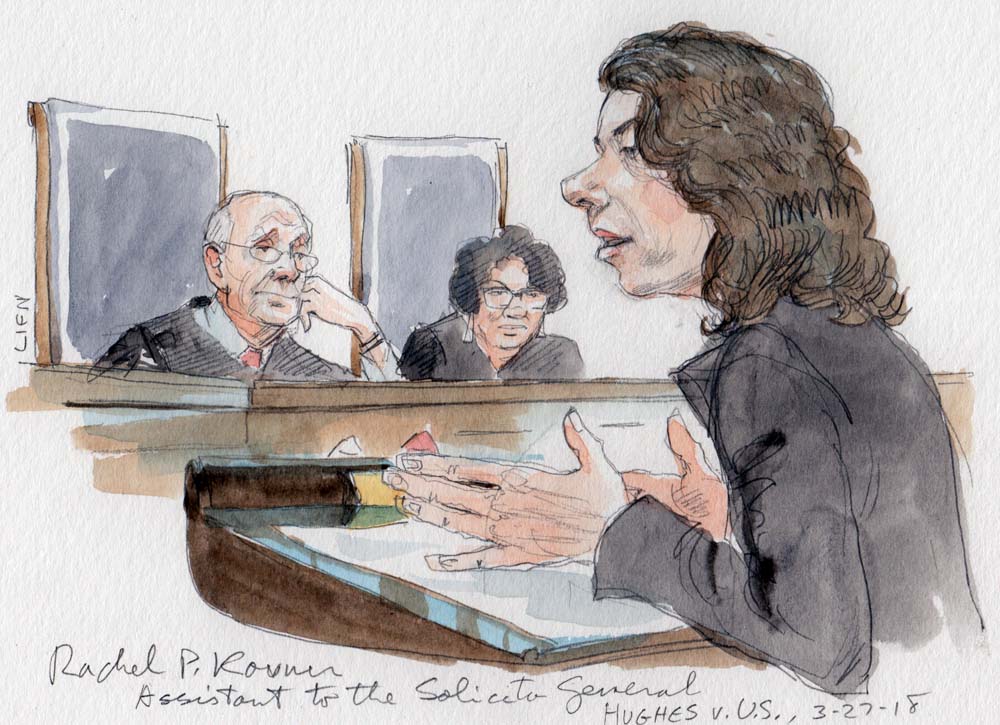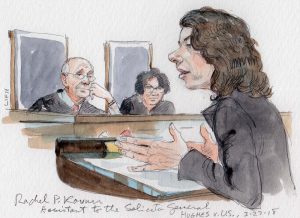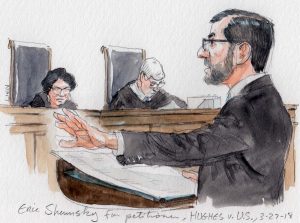Argument analysis: “We know how to get to five” – justices debate precedent in the absence of a majority opinion
on Mar 28, 2018 at 11:51 am

Erik Hughes was federally indicted in 2013 on four methamphetamine- and firearm-related offenses. He pleaded guilty to two charges, conspiracy to possess with intent to distribute at least 500 grams of methamphetamine and being a felon in possession of a firearm. The plea agreement between Hughes and the government — known as a “C-Plea,” named for Federal Rule of Criminal Procedure 11(c)(1)(C), in which the prosecutor and the defendant agree to a “specific sentence or sentencing range” — contained an explicit agreement to a below-guideline sentence of 180 months of imprisonment. About a year after Hughes pleaded guilty, the U.S. Sentencing Commission amended the Sentencing Guidelines, reducing the offense levels for certain drug offenses, including Hughes’ methamphetamine charge. Hughes filed a motion to reduce his sentence pursuant to 18 U.S.C. § 3582(c)(2), which permits a court to reduce the sentence of a defendant “who has been sentenced … based on a sentencing range that has subsequently been lowered by the Sentencing Commission.” The trial judge denied Hughes’ motion and the U.S. Court of Appeals for the 11th Circuit affirmed, explaining that a plea agreement that binds the sentencing court to a fixed term of imprisonment (180 months in this case) is not “based on” the sentencing guidelines as required for a sentence reduction.

Rachel P. Kovner, assistant to the U.S. solicitor general (Art Lien)
The case presents two important questions of federal law: one discrete question of statutory interpretation and one sweeping question about the ability of plurality decisions to create precedent. The first question is simply what “based on” the sentencing guidelines means as the phrase is used in 18 U.S.C. § 3582(c)(2). The second, larger question turns on what, if any, precedential weight to afford to the Supreme Court’s previous attempt to resolve the first question. In Marks v. United States, in 1977, the court held that “[w]hen a fragmented Court decides a case, … the holding of the Court may be viewed as that position taken by the Members who concurred in the judgment on the narrowest grounds.” This case asks whether one of the opinions from the court’s 4-1-4 plurality decision in Freeman v. United States created a binding rule of precedent under the “narrowest grounds” doctrine of the Marks rule.
Justice Sonia Sotomayor wrote a lone and decisive concurrence in Freeman (essentially concluding that a C-Plea is “based on” the sentencing guidelines only when the plea “expressly” invokes the sentencing guidelines), and lower courts have been fighting ever since over whether her lone opinion is the controlling precedent. Not surprisingly, Sotomayor was first out of the gate at argument with a slew of specific questions for Hughes’ counsel, Eric Shumsky. Sotomayor grilled Shumsky, for example, on whether the four-justice plurality in Freeman, which she did not join, could be read as rendering every defendant who enters a C-plea eligible for sentencing relief when the guidelines are amended. Shumsky ultimately conceded that under his reading of the statute, all sentences imposed pursuant to a C-Plea are “based on” the guidelines and are eligible to be revisited under Section 3553(a); indeed, Shumsky argued that only when the trial judge says something on the record equivalent to, “I’m not applying the guidelines at all, I disagree with the guidelines as a policy,” would a defendant not be eligible to have his sentence revisited when the guidelines are amended.

Eric Shumsky for petitioner (Art Lien)
This exchange lasted several minutes, with Sotomayor asking the first five questions of the morning. But just as the argument was veering into the weeds of statutory construction, Chief Justice John Roberts steered it back to the other question presented in the case: “how to apply Marks in this situation.” The remainder of Shumsky’s argument, and much of the argument of Rachel Kovner, the assistant to the solicitor general who represented the federal government in the case, focused on the Marks issue. Throughout the argument, hypothetical applications of the Marks rule in a variety of contexts were raised, from free speech to affirmative action and other constitutional questions, many of them far afield from the statutory interpretation question at issue in this case.
As to what should happen to the Marks rule, several justices and the attorneys seemed frustrated with the imperfect set of options. Based on their questions and statements during the argument, at least three to five justices appeared interested in either leaving the Marks rule alone or refining it in only minor ways.
The chief justice’s first question on this point is illustrative. Roberts suggested that what I have previously called the “Predictive Plurality,” or the reading of all the opinions (including the dissent) so as to predict the result in future cases, is the best understanding of the Marks rule. As Roberts put it, “any other approach” will result in appellate court reversal “because by definition, a majority of the Court … would reach a different result.” Shumsky responded to this practical approach of counting votes and predicting how a case would be decided by noting that, at least as currently articulated, the Marks rule does not purport to create binding precedent out of a dissent. Although lawyers and lower courts are certainly free (and wise) to count votes so as to predict what the Supreme Court might do, that is not the same thing as Supreme Court precedent. It is one thing to be a shrewd advocate or judge and be able to predict what the current Supreme Court would do with a very similar case, but it is quite another matter to engage in ad hoc “nose-counting,” as Shumsky put it, in order to define the binding precedent for a non-majority decision years, or even decades after it was decided and after the composition of the court has changed dramatically. Several justices, including Justices Elena Kagan, Samuel Alito and Sotomayor, however, seemed skeptical of any critique of the nose-counting approach to precedent.
Alito’s comments at times seemed to jibe with those of Roberts. Alito worried about the chaos that might ensue from abandoning the Marks rule altogether, but acknowledged that it could “certainly benefit from some clarification and … refinement.” Other justices also expressed dismay at the proposal of law professor Richard Re, who wrote a deft amicus brief arguing for the complete abolition of the Marks rule that received considerable attention during the argument. Balking at Re’s invitation to abandon the doctrine, Sotomayor explained that a confusing framework is better than no framework at all. Similarly, Kagan, in one of the most memorable exchanges of the argument, acerbically noted that although one can “talk about” whether to count dissenting votes or “give various theoretical objections” to a mere predictive form of the Marks rule, “We know how to get to five … even if the five depend on different reasoning.”
Kagan’s admonition likely resonates with many Supreme Court practitioners who, as a practical matter, seem to regard the Marks rule as operating in precisely such a pragmatic, not theory-driven, manner. Arguing for the United States, however, Kovner maintained that the Marks rule had reached a point of such confusion as to produce an intractable circuit split that needed to be resolved. When asked whether the government preferred that the case be decided on narrow, statutory grounds, Kovner said no. Justice Ruth Bader Ginsburg was quick to question the implication of the government’s position that precedent is created through “the opinion of only one [justice],” and even Kagan seemed dubious about that approach.
The justices recognize that the Marks rule is confounding lower courts and advocates, and for much of the argument their questions suggested that Hughes could provide a vehicle for resolving this confusion. But midway through the argument, such optimism ran into a roadblock. In a potentially crucial exchange, Justice Stephen Breyer spoke for the first time, explaining that in law school one learns that to read an opinion is “part art and part science.” Breyer continued that if he were forced to rewrite the Marks rule, he would have no idea how to do it, concluding that “they’ve done all right with Marks. Leave it alone.” Several minutes later, Justice Neil Gorsuch wondered aloud whether there is actually a problem with the Marks rule “outside of the Freeman context.”
The justices came to the argument ready to grapple with the alleged shortcomings of their 40-year-old Marks rule, but at the end of the hour, a majority of them seemed to have signaled a preference for tweaking or refining as opposed to abandoning the rule. At times, some justices appeared skeptical of any approach to the Marks rule that would constrain substantially the court’s ability to say that its plurality opinions always (or generally) announce binding precedent. Perhaps a majority of the justices oppose any material limitations on the Supreme Court’s power to announce precedent, even when the justices themselves fail to reach any meaningful agreement. Of course, when the justices are this active and the issue this unsettled, it is difficult to predict with certainty how they will rule. It is still possible that the court will conclude, as many lower courts have already, that the Marks rule often serves less as a clear indicator of discernible precedent, and more as an invitation for experimentation and percolation among the courts.


